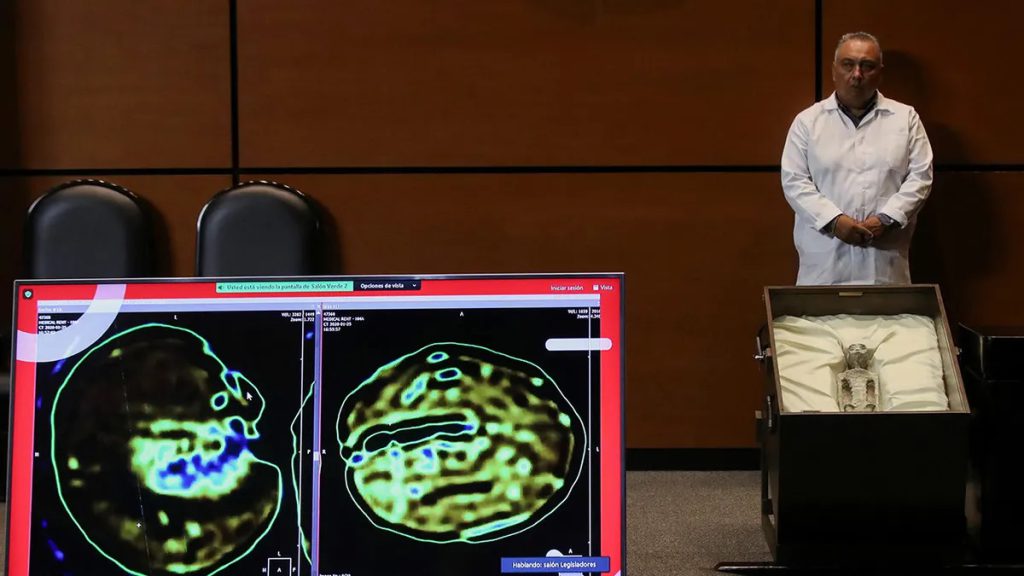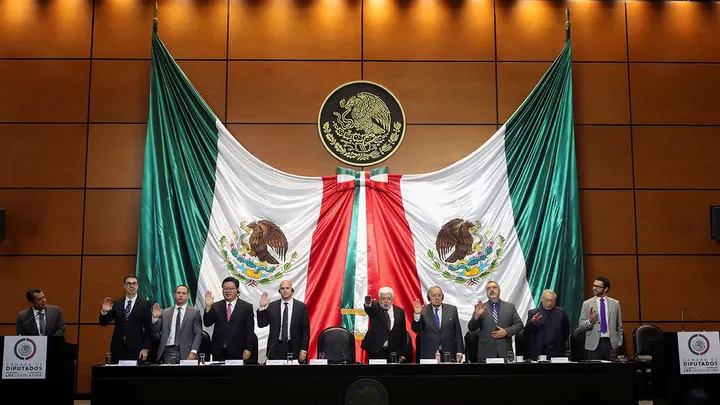In a historic session held on Tuesday, the Mexican Congress delved into the intriguing realm of Unidentified Anomalous Phenomena (UAPs), more commonly referred to as UFOs. This landmark event marked Mexico’s inaugural official governmental exploration of the subject, echoing the footsteps of recent inquiries in the United States.
At the center of this extraordinary hearing were artifacts presented as potential physical evidence substantiating the existence of extraterrestrial life. The artifacts, resembling small ‘corpses,’ were presented by Mexican journalist and UFO enthusiast, Jaime Maussan. Encased within glass display cases, these specimens possessed distinctive features: three fingers on each hand and elongated heads. Maussan claimed these remains were discovered near Peru’s ancient Nazca Lines in 2017 and, intriguingly, dated back approximately 1,000 years, as per carbon dating conducted by Mexico’s National Autonomous University (UNAM).
“We are not alone,” asserted Maussan passionately before the assembled lawmakers, contending that these remains constituted undeniable evidence of extraterrestrial existence.
However, UNAM issued a clarifying statement later, rebuffing any involvement in drawing conclusions about the origin of the samples. UNAM emphasized that their sole intent had been to ascertain the samples’ age.
Jose de Jesus Zalce Benitez, Director of the Scientific Institute for Health of the Mexican Navy, added his voice to the discussion, noting that a comprehensive examination of the remains had taken place. “I can affirm that these bodies have no relation to human beings,” he confidently stated.

Furthermore, the hearing featured testimony from Ryan Graves, a former U.S. Navy pilot who had previously testified before the U.S. Congress regarding his encounters with UAPs. Graves emphasized the need for a serious investigation into UAP phenomena and discussed the prevailing stigma surrounding UAP sightings.
Congressman Sergio Gutierrez, representing President Andres Manuel Lopez Obrador’s ruling Morena party, expressed hope that this event would inaugurate a series of similar hearings in Mexico. “We are left with reflections, with concerns, and with the path to continue talking about this,” Gutierrez remarked.
This hearing transpired during a time when governments across the globe, including the United States, are gradually shifting their stance on UAPs. The Pentagon’s active investigation into UAP sightings reported by military aviators and NASA’s imminent discussion of its own UAP study findings on Thursday underscore the burgeoning interest in this field.

Despite the high-profile nature of the event, Maussan’s claims have drawn skepticism and immediate backlash, notably from the scientific community and social media users. Critics pointed to previous instances where similar discoveries were later identified as mummified human children.
“This could really hinder efforts to take the issue seriously,” lamented one user on the X social media platform (formerly known as Twitter). Critics also questioned why the evidence was presented in a congressional hearing before undergoing a thorough peer review process.
In light of these developments, the debate surrounding the existence of UAPs and extraterrestrial life continues to captivate the world’s attention, as Mexico takes its first steps into this intriguing frontier.






